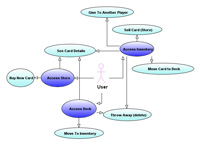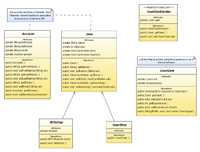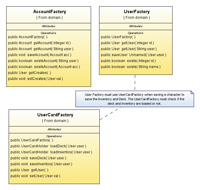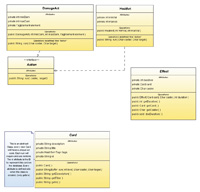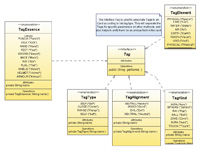
Web Card Game2007 (Java) Web Card Game
This is an overview of the project. I will list here only the main points which should first be developed to have a playable test version.
OverviewPersonal Objectives
Functional Requirements
Non Functional Requirements
Functional Requirements DescriptionThis section will only describe the requirements. Here I will only describe the main characteristics of the game. It will not discuss how to create, only explain the basic process. The description of how it should work is on the Use and Test Cases section. FR1: Battle between playersThis game is like a Role-playing Game. The player will be able to use their experience acquired after many fights to improve their attributes. Those attributes will increase their power and their Card Power. However this improvement will be minimal which will result in a possible enjoyable and fun fight between an recently created player and a elder player. This will also be possible because the game will be based on the cards and lucky (how they will appear in the combat and how strong their effects will be). FR2: Cards as main objectsThe cards must be the main objects of the game. They will define combats and how strong each player is. The cards will have a variety of characteristics and one of those characteristics is the experience which will define the strength of the card. Each card will have many actions which will be executed on their targets that can be also friendly targets (to help them), the actions and the strength of those actions will vary according to the Card’s respective experience. FR3: Player ChallengePlayers can fight other players and create challenges to make groups. Below is the description of how the Challenge Process should be. Simple Challenge View Description First of all, each player must be in the Lobby Frame and challenge each other to accept the combat. Once the combat is started the user view will change to the Combat Frame. They will fight by selecting actions such as using cards, items or running away. The fight will be turn based, every player will have their turn to do actions and wait for other players to do their actions. After sending the information they will be able to see the action results and then if the combat has finished it will go again to the Lobby Frame. Ideal Challenge View Description This is the final object to develop, but first we will create the above description to test. The main difference is that the players will be able to create the Challenge Frame and others players will be able to join the challenge and form groups. The creator of the challenge will also be able to define the rules and properties. FR4: Acquiring cardsThere will be some actions to do with cards. The players will be able to buy and sell cards, to gain from NPCs (quests), to gain from levels and to bet. Game Basic DataThis section will only list the basic information for every Entity of the game. The characteristics listed here are exactly priority to be develop. GD:ACC - AccountThis will be the information about the player as a person. This will only be needed on later stages when the alpha is finished.
GD:CHR - CharacterThis is the basic information of every Character. An account can have many characters. The character is the player representative in the game (aka Avatar). In the early stages the character will also hold the account information such as password and email.
GD:BTL – Battle
GD:CRD – CardEvery Character can have many cards. The players will be able to see the description and characteristics and during the combat the card’s actions will be used.
Game FramesThis section will describe the screens where the player will interact with the application (the Views). This will describe all game views and every possible action of the player. GF:LOB – Lobby Frame This is the first screen of the game it is showed when the player is enters in the system. At first, just to simplify, it will only have a simple chat where the player can see every other logged player and do the main actions such as Challenge Other Player, Access his Deck. Later we will have other actions as for example Access Store, Create Challenge, Train, Status, Change Channel, Clan and Story (it is something to think about it) GF:CMB – Combat Frame This is the combat interface. Here we will be able to see all participants of the combat and in the middle we will have the description of the combat. At the bottom the player will be able to select the card to use in his turn. There will be other actions as Run. Use and Test CasesThis section will describe how the things are going to work and to which Functional Requirement and Game Basic Data is related. Card Case (FR2, GD:CRD) There will be many cards. Every player will have likely 100 cards or maybe more (counting with the inventory) and every Card will have one or more action. There is a pattern of the card actions and many cards probably will have similar effects, changing maybe only the intensity. That is why every card and every action will be static classes with only one object instanced. To execute one Card we will need the person who used (Caster), the target and how much experience this person has with this Card. This experience will define which sequence of actions will be executed on the target. There will be a few effects that an action can cause, those are instant, triggered and temporary. Challenge View Case (FR1, FR2, GD:CRD, GD:CHR, GF:CMB, GF:LOB) When one user challenge another we will define a flag and when the other user challenge back that means the user have accepted the combat. Before being accepted, the challenge can be cancelled or denied. The combat will start and the users and all combat details will be loaded in memory. The combat object is who will control the combat by holding the players, passing and controlling the turns. Every player will have 60 seconds to do their actions, if no action is made the turn will be skipped automatically. In this stage, the user can Run from the combat, Use a card or Skip the Turn. Since we are using a web interface the user will have to constantly check the results for chat and to see the other player action, by this check we can also do the timeout. Challenge Accepted Case When the challenge is accepted the Battle object will create and every user involved will create its own BattleUser information. The BattleUser object will contain every battle information such as the Hand, Current Deck, Effects and to which battle is this user associated. This way we have both ways, to get the user from the battle and the the battle from the user. Once the combat is started the users will be locked to this part of the site and the Battle will be associated to the user section. This way we will avoid the user accessing other game pages while fighting. Combat Turn Case (FR1, FR2, GD:CRD, GD:CHR, GF:CMB) UA (User A) and UB (User B) have challenged each other and they are now in the Combat Frame. UA will start the combat and he selects the card named Fire Attack. This card has two effects, first it causes instant damage on the target and half of the damage caused on the next two turns. Now it is UB turn, it receives the damage from the UA’s card and then uses the card Titan Skin. This card have also two effects: first, it will increase his strength for the next physical attack that he do and second it reduces all received physical damages for a few turns. This means that UB has now three effects on him, two are temporary and another is triggered. Then starts the UA turns, and he uses the card Slash Attack. This card has only one effect which is to cause a physical damage on the target. However, UB has a temporary effect on himself and this damage will be reduced. Note: triggered effects are not priority. |
|
